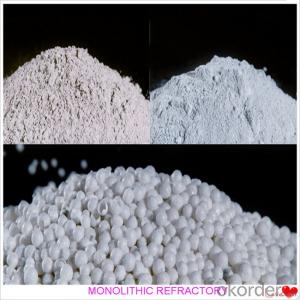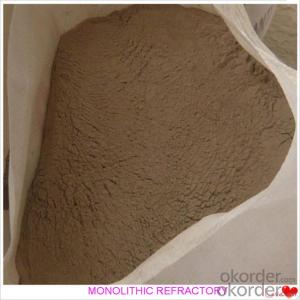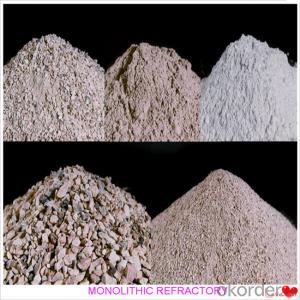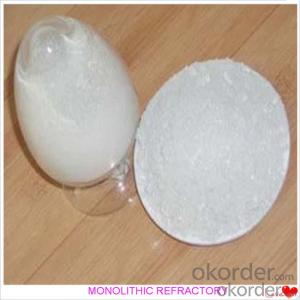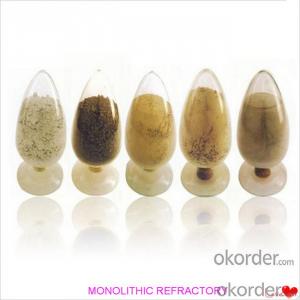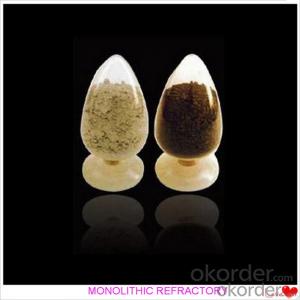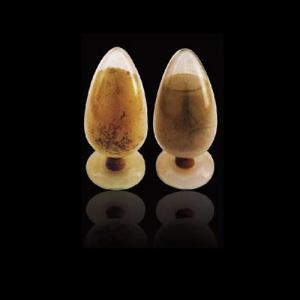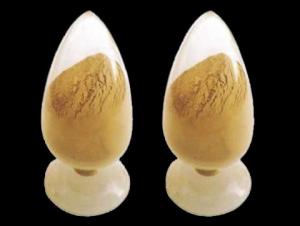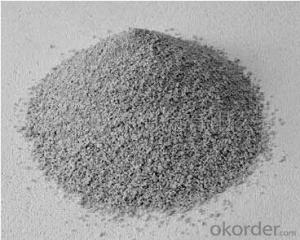Steel Fiber Castable For Fireplace and Industrial Furnace
- Loading Port:
- China main port
- Payment Terms:
- TT OR LC
- Min Order Qty:
- 1000 kg
- Supply Capability:
- 3000000 kg/month
OKorder Service Pledge
OKorder Financial Service
You Might Also Like
Steel Fiber Castable For Fireplace and Industrial Furnace
Product Description:
Steel fiber castable is manufactured according to international standards. The product is famous for its excellent abrasion resistance and low thermal conductivity. Further, these can be provided in different specifications as required by the clients. The Steel fiber castables are used high purity raw materials and additives as the main material, and made of under superfine powder adding technology.
Product Advantages:
The material has excellent structural stability and air tightness, and has high physical and chemical properties, also has a fine working ability.They should be used with the same material products.They are widely used in various kinds of kiln lining.Such as boiler, blast furnace hot blast stove, heating furnace, ceramic kiln, etc.Furnaces of metallurgy industry, heat treatment furnace. Furnace of incineration of garbage, recirculating fluidized bed furnace. Furnaces of chemical industry and construction industry.
Product Applications:
For feature of Steel fiber castable, they have excellent abrasion resistance, thermal shock resistance, high-temperature resistance, anti-corrode and have high intensity.
Designed for refractory lining of blast furnace iron and slag runners, skimmers and soon
They can be used in troughs of small and mid size BFs and in all positions of the troughs where fast tapping is required.
Main Product Features:
1. High refractoriness, High refractoriness under load.
2. High density, low porosity.
3. Good slag resistance and corrosion resistance.
4. High strength and wear resistance.
5. Good resistance to flake performance.
6. Good thermal shock stability.
7. Scouring resistance
8. Good hot strength.
Product Specifications:
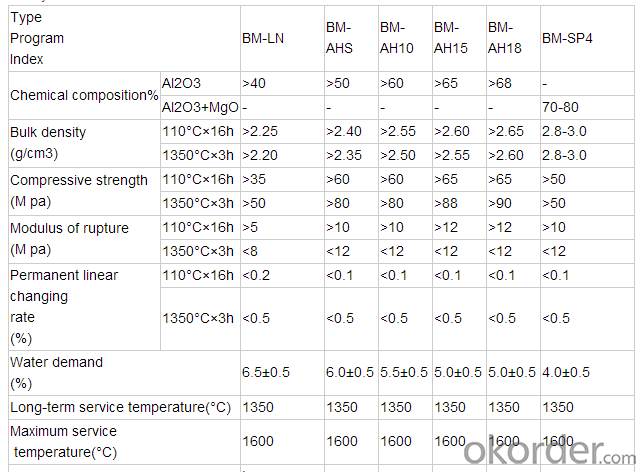
FAQ:
1. How you can control your quality?
For each production processing, we have complete QC system for the chemical composition
and Physical properties. After production, all the goods will be tested, and the quality certificate
will be shipped along with goods.
2. What's your delivery time?
It usually needs about 20days- 45 days after receiving the deposit.
3. Do you provide free samples?
Yes, we can provide a free sample for testing, If we have sample in stock,
The quantity based on the material type, The buyer should bear all the shipping costs.
4. What's your payment terms?
We can accept 30% deposit, 70% balance before shipment for ordrs over $ 2000.
5. Can we visit your Company?
Yes, certainly. You are very welcome to China and we will be honored to have a customer and friend.
Product Picture:



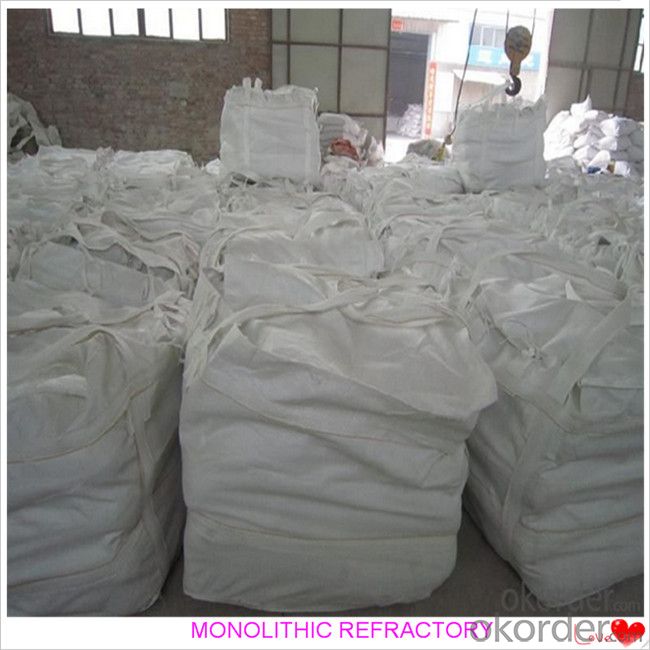
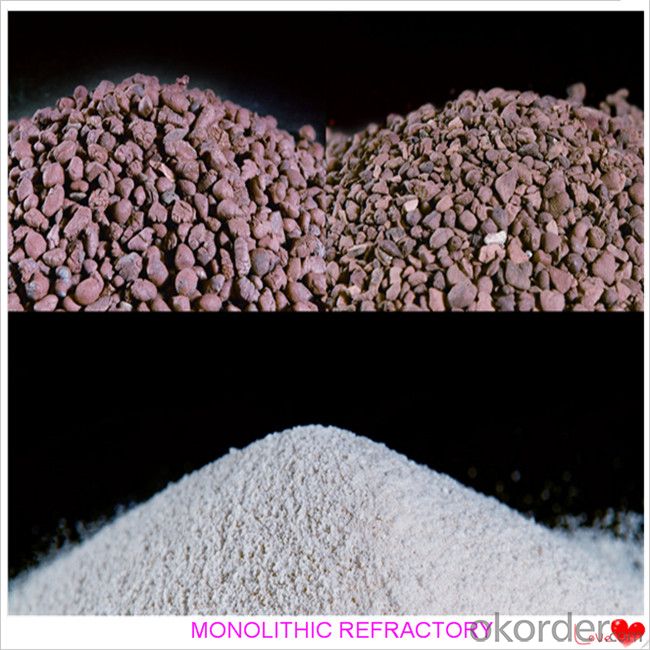
- Q:What are the key characteristics of monolithic refractories for electric arc furnace applications?
- The key characteristics of monolithic refractories for electric arc furnace applications include excellent thermal shock resistance, high erosion and corrosion resistance, good mechanical strength, and the ability to withstand high temperatures and aggressive chemical environments. Monolithic refractories also offer easy installation and maintenance due to their shape versatility and ability to be cast or gunned into place, ensuring optimal performance and longevity in electric arc furnace operations.
- Q:What are the specific requirements of monolithic refractories for continuous casting applications?
- To withstand the extreme temperatures and thermal shock conditions experienced during continuous casting, monolithic refractories have specific requirements. First and foremost, these refractories must possess high thermal conductivity, enabling them to efficiently transfer heat away from the molten metal and maintain a stable casting temperature. This is crucial in preventing the formation of defects such as cracks, hot spots, and uneven solidification in the cast product. Secondly, monolithic refractories for continuous casting applications need to exhibit high refractoriness. This means they can endure the high temperatures of the molten metal without melting or deforming, ensuring the refractories can provide a protective lining and maintain their structural integrity throughout the casting process. In addition, these refractories must demonstrate excellent resistance to thermal shock. The continuous casting process involves rapid cooling and heating cycles, resulting in significant temperature differentials and inducing thermal stresses. Monolithic refractories with low thermal expansion and high thermal shock resistance can endure these conditions without cracking or spalling. Moreover, good erosion and corrosion resistance are vital requirements for monolithic refractories in continuous casting applications. The molten metal and slag can be highly corrosive and abrasive, causing wear and chemical attack on the refractory lining. Therefore, refractories with high resistance to erosion and corrosion are essential to ensure the longevity and stability of the lining. Lastly, monolithic refractories for continuous casting applications should possess good workability and ease of installation. This allows for efficient and precise lining installation, minimizing downtime during maintenance or repairs. Overall, the specific requirements for monolithic refractories in continuous casting encompass high thermal conductivity, refractoriness, thermal shock resistance, erosion and corrosion resistance, as well as good workability. Fulfilling these requirements guarantees that the refractories effectively safeguard the casting equipment and maintain the quality of the cast products.
- Q:How do monolithic refractories protect lining in ladles and tundishes?
- Monolithic refractories protect lining in ladles and tundishes by forming a strong and durable barrier against the harsh conditions of high temperatures, thermal shock, and chemical corrosion. They are designed to withstand the extreme heat and mechanical stresses that occur during metal pouring and handling, ensuring the integrity and longevity of the lining. Additionally, monolithic refractories provide excellent insulation properties, reducing heat loss and conserving energy in the ladles and tundishes.
- Q:How do monolithic refractories improve energy efficiency in the iron and steel industry?
- Various mechanisms are employed by monolithic refractories to enhance energy efficiency in the iron and steel industry. To begin with, these refractories possess exceptional insulation properties that effectively minimize heat loss during production. This results in a higher retention of heat within the furnace, thereby increasing energy efficiency. Furthermore, monolithic refractories exhibit low thermal conductivity, facilitating improved heat transfer within the furnace. This allows for efficient distribution of the heat generated during production, enabling optimal temperature control and reducing energy wastage. Additionally, monolithic refractories demonstrate high resistance to thermal shock and corrosion, which are common challenges faced in the iron and steel industry. By enduring extreme temperatures and chemical reactions, these refractories prevent premature wear and tear, consequently reducing the need for frequent repairs and replacements. This not only conserves energy but also minimizes downtime, leading to enhanced productivity and energy efficiency. Moreover, the utilization of monolithic refractories enables better furnace design and optimization. Their flexibility permits the creation of bespoke shapes and linings that cater to specific furnace requirements, resulting in improved heat transfer and combustion efficiency. This customized approach promotes energy savings by maximizing fuel utilization and reducing emissions. Lastly, monolithic refractories possess a longer lifespan compared to conventional brick refractories. This prolonged durability reduces the frequency of refractory replacements, subsequently lowering the energy consumption associated with the manufacturing and installation of new refractories. Overall, monolithic refractories play a significant role in enhancing energy efficiency in the iron and steel industry by reducing heat loss, improving heat transfer, withstanding thermal shock and corrosion, enabling better furnace design, and increasing refractory lifespan. Their usage not only saves energy but also enhances productivity and sustainability within the industry.
- Q:How do monolithic refractories withstand the mechanical impacts in ladle lip applications?
- Monolithic refractories are able to withstand mechanical impacts in ladle lip applications due to their high density, strength, and resistance to thermal shock. These refractories are designed to have excellent impact resistance, preventing any cracks or fractures from occurring when the ladle is being handled or poured. Additionally, they have a high refractoriness, ensuring that they can withstand the extreme temperatures experienced during the metal pouring process.
- Q:What are the challenges in recycling monolithic refractories?
- One of the main challenges in recycling monolithic refractories is their composition. Monolithic refractories are typically made from a combination of different minerals, binders, and additives, which can make the separation and recovery of individual components difficult. Additionally, the high temperatures at which monolithic refractories are used can cause chemical reactions and physical changes that affect their recyclability. Furthermore, the presence of contaminants, such as metal oxides or impurities from the manufacturing process, can also pose challenges in the recycling process. Overall, developing efficient and cost-effective recycling methods for monolithic refractories requires addressing these challenges and finding innovative solutions.
- Q:How are monolithic refractories installed and repaired in iron and steel production facilities?
- Monolithic refractories are vital components in iron and steel production facilities, as they provide insulation and protection against high temperatures, chemical corrosion, and mechanical wear. The installation and repair processes for monolithic refractories in these facilities require careful planning, expertise, and adherence to safety protocols. When installing monolithic refractories, the first step is to prepare the surface by removing any loose material and cleaning the area thoroughly. This ensures proper adhesion of the refractory material. The surface may also need to be roughened or textured to improve bonding. Next, the monolithic refractory material is mixed with water or a binder to create a workable consistency. It is then applied to the prepared surface using various methods such as casting, gunning, ramming, or troweling. The choice of application method depends on factors such as the type of refractory material, the area being repaired, and the desired outcome. During installation, it is essential to carefully follow the manufacturer's instructions regarding mixing ratios, curing times, and drying temperatures. Improper installation can lead to reduced refractory performance, premature failure, and safety hazards. Repairing monolithic refractories in iron and steel production facilities is an ongoing process due to the harsh operating conditions and mechanical stresses they endure. When a refractory lining shows signs of damage or wear, it is crucial to address the issue promptly to prevent further deterioration. The first step in repairing monolithic refractories is to assess the extent of the damage. This can be done through visual inspection, thermal imaging, or non-destructive testing techniques. Once the damage is identified, the repair method can be determined. Minor repairs can often be carried out using patching materials. These materials are typically the same or similar to the original refractory composition and are mixed with water or a binder to form a paste. The paste is then applied to the damaged area and allowed to cure. For more extensive repairs, the damaged refractory material may need to be removed entirely. This can be done through mechanical methods such as chipping, grinding, or cutting. After the damaged material is removed, the surface is prepared as mentioned earlier, and new refractory material is installed using the appropriate application method. It is important to note that the repair process should be conducted by trained personnel with expertise in refractory installation and repair. Safety precautions such as wearing protective clothing, using proper tools, and following established procedures should always be observed. In conclusion, the installation and repair of monolithic refractories in iron and steel production facilities require careful planning, adherence to manufacturer's instructions, and expertise in refractory materials. By following proper procedures and promptly addressing any damage, these facilities can ensure the longevity and efficiency of their refractory linings, ultimately contributing to the smooth operation of their production processes.
- Q:What are the advancements in monolithic refractory technology for the iron and steel industry?
- There have been significant advancements in monolithic refractory technology for the iron and steel industry in recent years. Monolithic refractories are a type of heat-resistant material used to line the walls and floors of high-temperature industrial processes, such as those involved in iron and steel production. One of the key advancements in monolithic refractory technology is the development of new and improved materials. Traditional refractory materials, such as firebricks, have been replaced by more advanced materials like castables and gunning mixes. These new materials offer superior performance in terms of thermal conductivity, thermal shock resistance, and erosion resistance. They can withstand higher temperatures and can be applied more efficiently, resulting in improved process efficiency and reduced downtime for maintenance. Another important advancement is the use of advanced additives in monolithic refractories. These additives can enhance the properties of the refractory material, such as increasing its resistance to corrosion and erosion. They can also improve the bond between the refractory and the substrate, ensuring a longer lifespan for the lining. Furthermore, advancements in monolithic refractory technology have led to the development of innovative installation techniques. For instance, shotcreting, a process that involves spraying the refractory material onto the surface, has gained popularity due to its efficiency and ability to provide a uniform lining. Similarly, the use of gunning machines, which pump the refractory material at high velocity, has improved the speed and accuracy of installation. Moreover, there have been advancements in the design of monolithic refractories specifically tailored for different applications in the iron and steel industry. Refractories for blast furnaces, ladles, tundishes, and other critical equipment have been optimized to withstand the unique challenges and harsh conditions of these processes. The development of specialized monolithic refractories has resulted in increased productivity, reduced energy consumption, and improved product quality in the iron and steel industry. In conclusion, advancements in monolithic refractory technology for the iron and steel industry have brought about improved materials, advanced additives, innovative installation techniques, and specialized designs. These advancements have significantly enhanced the performance, durability, and efficiency of refractory linings in high-temperature industrial processes. As a result, the iron and steel industry can benefit from increased productivity, reduced downtime, and improved product quality.
- Q:How do monolithic refractories perform in aluminum holding furnace applications?
- Monolithic refractories have proven to be highly efficient and effective in aluminum holding furnace applications. These refractories are specifically designed to withstand the extreme temperatures and chemical environments encountered in these furnaces. One key advantage of monolithic refractories is their ability to form a continuous, seamless lining in the furnace. This eliminates the need for individual bricks or tiles, reducing the risk of thermal shock and cracking. The absence of joints also minimizes the chances of molten aluminum leaking through the lining, ensuring better containment and heat retention. Monolithic refractories also offer excellent thermal insulation properties, which are crucial in aluminum holding furnaces. They have low thermal conductivity, which helps to reduce heat loss and maintain a stable temperature within the furnace. This results in improved energy efficiency and reduced operating costs. Moreover, monolithic refractories have excellent resistance to corrosion and chemical attack from molten aluminum and its by-products, such as dross and fluxes. This resistance ensures a longer service life for the refractory lining, reducing maintenance and downtime. Additionally, monolithic refractories are known for their easy installation and repair. They can be installed quickly and easily, requiring minimal downtime for furnace maintenance. In case of any localized damage or wear, repairs can be made efficiently by patching or spraying the affected area. In summary, monolithic refractories are an ideal choice for aluminum holding furnace applications due to their seamless lining, thermal insulation properties, resistance to corrosion, and easy installation and repair. These refractories significantly contribute to the overall performance and efficiency of aluminum holding furnaces.
- Q:How are monolithic refractories recycled or disposed of at the end of their lifespan?
- Monolithic refractories at the end of their lifespan are typically recycled or disposed of through various methods. Recycling involves collecting the used refractory materials and processing them to remove any contaminants. The processed refractories can then be used as raw materials in the production of new refractory products. Disposal methods include landfilling in designated areas or utilizing waste-to-energy facilities to convert the refractories into energy. The choice between recycling and disposal depends on factors such as the condition of the refractories and the availability of recycling facilities in the area.
1. Manufacturer Overview |
|
|---|---|
| Location | |
| Year Established | |
| Annual Output Value | |
| Main Markets | |
| Company Certifications | |
2. Manufacturer Certificates |
|
|---|---|
| a) Certification Name | |
| Range | |
| Reference | |
| Validity Period | |
3. Manufacturer Capability |
|
|---|---|
| a)Trade Capacity | |
| Nearest Port | |
| Export Percentage | |
| No.of Employees in Trade Department | |
| Language Spoken: | |
| b)Factory Information | |
| Factory Size: | |
| No. of Production Lines | |
| Contract Manufacturing | |
| Product Price Range | |
Send your message to us
Steel Fiber Castable For Fireplace and Industrial Furnace
- Loading Port:
- China main port
- Payment Terms:
- TT OR LC
- Min Order Qty:
- 1000 kg
- Supply Capability:
- 3000000 kg/month
OKorder Service Pledge
OKorder Financial Service
Similar products
New products
Hot products
Related keywords
